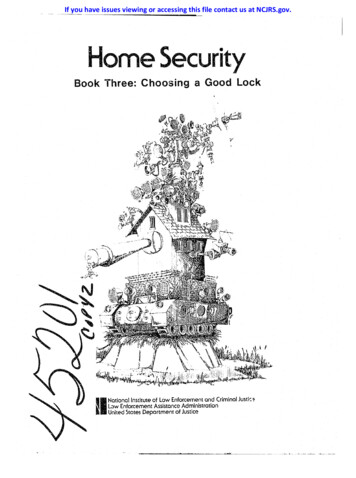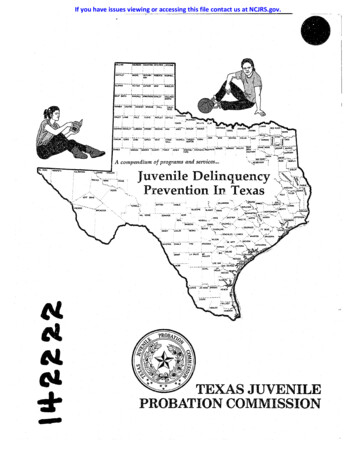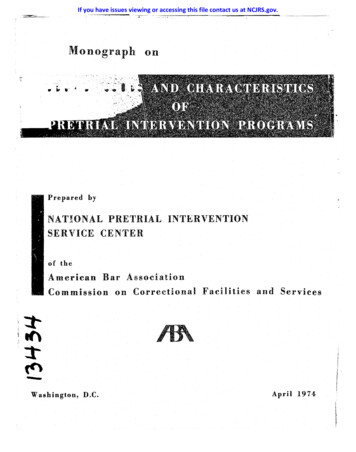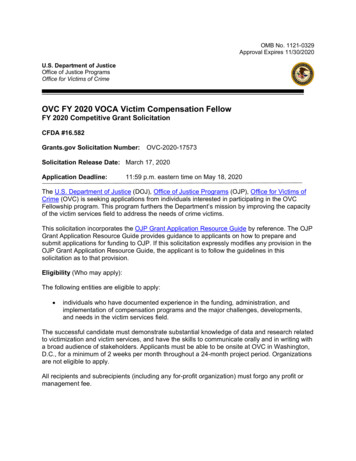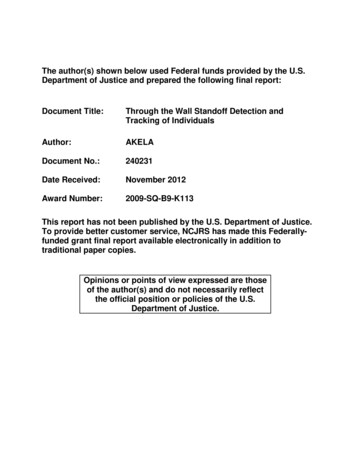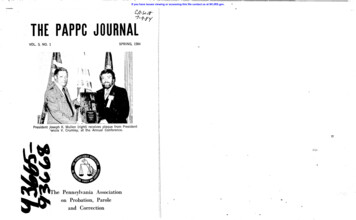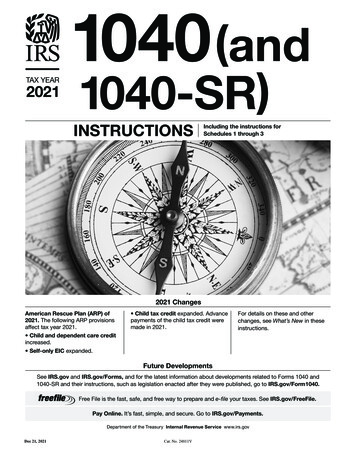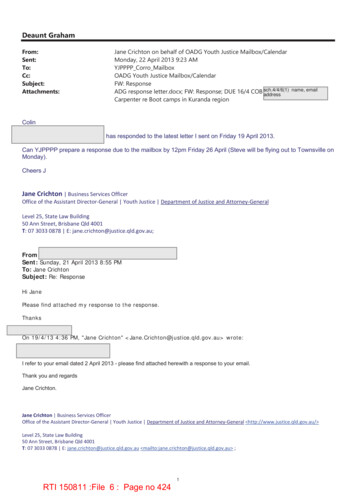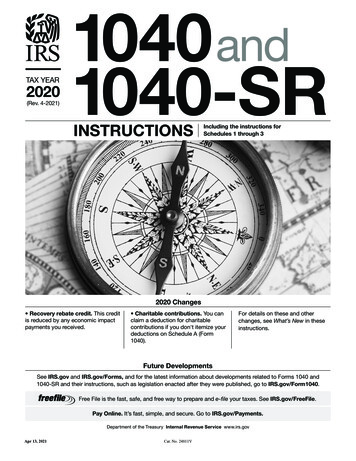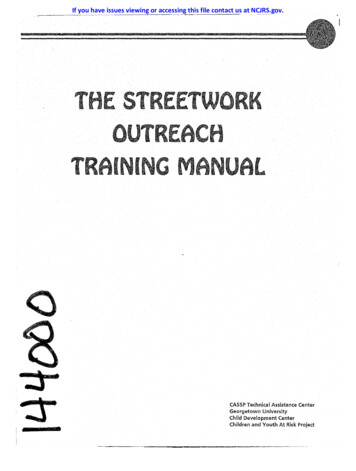
Transcription
If you have issues viewing or accessing this file contact us at NCJRS.gov.I ILCASSP Technical Assistance CenterGeorgetown Universitychild Development CenterChildren and Youth At Risk Project
ERRATAPlease add the following programs to the Resource List on p. 118 inAppendix 2 and delete them from pps. 147-149 in Appendix 6.p.147p. 148 cont.Alaska Youth InitiativeChild and Adolescent Mental HealthDivision of Mental Health/Developmental DisabilitiesBox H-04Juneau, AL 99811YWCA Runaway17 Harriet StreetSpringfield, MA 01107413-731-9737p. 149p. 148Garfield Youth Services902 Taughenbaugh, Suite 302Rifle, CO 81650303-625-3141Washington Institute ForEmployment Training3224 16th Street, N.W.Washington, DC 20010202-265-2626Wave, Inc.501 School Street, S.W.Suite 600Washington, DC 20024202-484-0103Youth Crisis CenterP.O. Box 16567Jacksonville, FL 32245904-725-6852Kaleidoscope1279 N. MilwaukeeSuite 250Chicago, IL 60622312-278-7200Covenant House14 Williams StreetNewark, NJ 071 02212-613-0300CrossroadsP.O. Box 321Lumberton, NJ 08048609-261-5400The Children's Health Fund317 East 64th StreetNew York, NY 10021212-535-9400Planned Parenthood ofNew York CityStreet Beat Program349 East 149th Street, Room 601Bronx, NY 10451718-274-7223National Resource Center ForYouth ServicesThe Univesity of Oklahoma202 West Eight StreetTulsa, OK 74119-1419918-592-1841
THE STREETWORKOUTREACH TRAININGMANUALTrudee Able-PetersonJune Buey144000U.S. Department of JusticeNational Institute 01 JusticeThis document has been reproduced exactly as received from theperson or organization originating it. Points of view or opinions stated Inthis document are those of the authors and do not necessarily representthe official position or policies of the National Institute of Justice.Permission to reproduce this -sqy!' I Jep material has beengranted byPublic Danain/tJ. S. Dept. ofHealth and Human Servicesto the National Criminal Justice Reference Service (NCJRS).Further reproduction outside of the NCJRS system requires permissionof the owner.U.S. DEPARTMENT OF HEALTH AND HUMAN SERVICESPublic Health ServiceSubstance Abuse and Mental Health Services AdministrationCenter for Mental Health ServicesDivision of Demonstration ProgramsChild and Adolescent Service System Program (CASSP)
This report is funded by the Substance Abuse and Mental Health Services Administration (SAMHSA); Center for Mental Health Services, Division of Demonstration Programs, Child and Adolescent Service System Program (CASSP). All material appearingin this volume is in the public domain and may be reproduced or copied withoutpermission from SAMHSA, CASSP, or the authors. Citation of the source is appreciated.Copies are available from:CASSP Technical Assistance CenterGeorgetown University Child Development Center3800 Reservoir Road, NWCO-52 Bles, PediatricsWashington, DC 20007202-687-8635Printed 1993
FOREWORDThe Child and Adolescent Service System Program (CASSP) withinthe Center for Mental Health Services, has emphasized, in workingwith the States, the development of the infrastructure necessary forsystem improvement and for the development of an array of servicesin communities for children and youth with, or at risk of, seriousemotional disturbance. The definition of at risk of serious emotional,behavioral, or mental disorders include children and youth, but arenot limited to those who are homeless, either as part of a family unitor alone; those living with parents who are unable to provide adequatecare and nurturance, including drug-addicted parents; those who havebeen victims of violence; those who abuse alcohol and/or other drugs;those who are HIV infected; those with a family history of psychiatricillness; and those with multiple out-of-home placements. Children andyouth who are living on the streets, in abandoned buildings, and inparks are clearly members of , hat population CASSP is targeting.Streetwork is a critical component in a comprehensive service systemwhich is, like a seamless garment, without gaps or holes.Jean Garrison-Athey, formerly of NIMH-CASSP, supported JuneBucy, founder of the National Network of Runaway and Youth Services, in developing this training document on street work and outreachto homeless and runaway youth. She shared June's conviction thatthere was a technology that needed to be understood, documented, andthen transferred to other communities. June diligently interviewedcountless people in programs across the country, carefully documenting all the information they shared with her and communicating it ina straightforward, nonthreatening way. Her life-long commitment to,and knowledge of, these children and youth shines through.Trudee Able-Peterson was asked to contribute the perspective ofsomeone who developed and nurtured a streetwork program in one ofthe most intimidatin:g cities in America, in a neighborhood delugedwith hustlers preying on children., youth, and other vulnerable humanbeings. Trudee has walked the cold, threatening streets; rocked theraped, beaten, crying child to sleep; comforted the shocked, grievingstreetworker over the suicide of one of the kids; educated a bewildered12-year-old about HIV/AIDS; buried a teenager who died of AIDS;knocked on doors to ask for money to keep the program alive; pleadediii
STREETWORK OUTREACH TRAINING MANUALwith politicians to develop laws to protect children; shared her visionwith hospital workers, police officers, lawyers, and church groups, ofa society that does not exploit and harI!1 children but one that embracesthem, halts the injustices against them, recognizes their talents andtheir dreams, and builds on them.Finally, we used the youths own words whenever possible. However,with more time and greater resources we would have included themin the creation and production of this manual. They will be so involvednext time.Diane M. DohertyDirectorChildren and Youth At-Risk ProgramGeorgetown University Child Development CenterCASSP Technical Assistance CenterDiane L. SondheimerChiefChild and Adolescent Studies ProgramChild, Adolescent and Family BranchDivision of Demonstration ProgramsCenter for Mental Heath Servicesiv
PREFACEThis manual, developed under a contract with the Center on MentalHealth Services, Substance Abuse and Mental Health Services Administration, is intended as a guide for action for people concerned aboutthe youths who live alone on the streets of America without thenurture, protection, and supervision of caring adults. The number ofthese youth is unknown, but conservative estimates indicate that eachyear 100,000 to 300,000 adolescents become separated from theirfamilies and their homes. However, the National Network of Runawayand Youth Services! estimates that each year, 1 million to 1.3 millionyouth run away from their homes as the result of abuse, violence, andfamily conmct.In a small number of communities, individuals, religious or civic groups,or public or private agencies have reached out to help. One response hasbeen to go where the kids are-out into the streets-to listen and learn.Having listened, creative and committed people have devised strategiesand programs that offer respect to the young people and support forpositive changes the youth can make. Most of the material in this manualis derived from the experience of such providers.Streetworkers respect for young people and their enthusiasm forempowering youth to make changes in their lives are tempered by theiracquaintance with the pain and isolation experienced by many of theyouth on the street. Their innovative techniques are firmly rooted insociological and psychological theory and sophisticated strategies thatare often obscured by the ease wit which they wear their "streetclothes" and hang out in unobtrusive ways. Their language shiftseasily between pithy street vernacular and professional jargon.One characteristic they seem to share is an openness, almost aneagerness, for questions, critiques, and thoughtful dialog about theirwork. They know they are inventing a technology that is a powerfulforce in bringing hope, health, and safety, not only to youth forced to1 The National Network of Runaway and Youth Services. To Whom Do They Belong?Runaway, Homeless, and Other Youth in High-Risk Situations in the 1990s. Washington, DC: the Network, 1991.v
STREETWORK OUTREACH TRAINING MANUALa homeless street existence, but to millions of American youth who areat risk of becoming homeless.We have talked with most ofthe people mentioned in this manual andvisited many of the programs. We have thereby become inheritors ofthe oral tradition that has built this new service model. Some 25program providers struggled with a survey instrument (appendix 1)to describe their work and their learning. Many of them have sharedwith us, and thus with you, their own documents, data. trainingmaterials, reports, and stories of young lives with an unselfishnessthat we fInd amazing. We owe each of them a debt of gratitude.Participating programs are listed in appendix 2.All of the people who shared their learning expressed concern aboutthe not-yet developed techniques and unanswered questions. Eachstressed the uniqueness of each community and the necessity ofstaying attuned to changes. These youth service pioneers know thatthey are a knowledge bridge over which information and experienceswith homeless youth will come into the consciousness of people whocan create a climate of public understanding. They believe that eventually this understanding will lead to public forums and policy decisions that will address not only the individual suffering of youngpeople but the costs to our national strength of throwing youth away.This manual attempts to describe the varied activities, knowledge, andskills an outreach program needs to provide services to these youthwho are living on our streeets. It is not a complete guide, particularlyin the areas of counseling techniques, substance abuse prevention, andfundraising, where more indepth information is readily available.We have become increasingly concerned that homeless youth arefalling through the cracks, not only of public agencies and traditionalservices, but of agencies that once prided themselves on responding tothe needs of children most at risk. Americans have become aware ofthe large population of people who are homeless. Some citizens andpolicymakers even recognize that families, most often mothers andtheir young children, are the fastest growing segment of the homelesspopulation. As a Nation we have not yet, however, managed to realizethat thousands of adolescents roam our streets, disconnected fromfamilies, from health and mental health care, education, employment,housing, and a sense of belonging to our society. This manual isdedicated to those youth in the hope that they will soon be welcomedback into our communities of concern.vi
ACKNOWLEDGMENTSI would like to thank Marsha Day and Victims' Services Agency fortheir vision and creation of The Streetwork Project of N.Y. C.; BeatrizRuiz, because you are the young person who took a chance to believein yourself and you taught me that the program could succeed; IleneFreund-Ford. my first partner in streetwork-I am so grateful youwere there with me. I would also like to thank Diane Doherty, DianeSondheimer, Helene Lauffer, Margo Hirsch, Lutz Kratzschmer, JerryFest, the Center for Mental Health Services, and Hamburger StiftungZur Forderung Von Wissenschaft Und Kultur for their assistance andsupport throughout the writing of this manual and the streetworkprograms that contributed to the manual.Trudee Able-PetersonMost of the material in this manual is derived from the experiences ofproviders. I would like to thank all of the people who shared theirlearning with me and expressed concern about the not-yet developedtechniques for working with homeless youth and the unansweredquestions about streetwork. All stressed the uniqueness of their communities and the necessity of staying attuned to changes.To me, however, the most remarkable insight is that every respondentand program emphasized the same message-the young people matter, they must not be forgotten, and we can make a difference.June Bucyvii
CONTENTSPageFOREWORD . ,. iiiPREFACE.vACKNOWLEDGMENTS . viiChapter I-THE NATURE OF THE PROBLEM. . . . . . . . . . . . . 1Life on the Streets . . . . . . . . . . . . . . . . . . . . . . . . . . . . . . 1The Scope of the Problem .2Why They Run . . . . . . . . . . . . . . . . . . . . . . . . . . . . . . . . . . . . . . . 4The Street Subculture . . . . . . . . . . . . . . . . . . . . . . . . . . . . . . . . 9The Street Hierarchy. . . . . . . . . . . . . . . . . . . . . . . . . . . . . . . . . 10Why They Stay. . . . . . . . . . . . . . . . . . . . . . . . . . . . . . . . . . . . . . 12References . 13Chapter 2-ADDRESSING THE PROBLEM . . . . . . . . . . . . . . .The Roots of Streetwork .Underlying Principles of Streetwork . ,The Role of a Streetworker . ,Nonjudgmental Engagement .Developing Relationships of Trust . ,Advocacy and Access . . . . . . . . . . . . . . . . . . . . . . . . . . . . . . .Counseling and Client Education. . . . . . . . . . . . . . . . . . . . .Referral Resources and Assessing Youths' Needs. . . . .A Look at Two Streetwork Programs . " . ,References . ,.1515181818192020212226Chapter 3-PLANNING A STREETWORK PROGRAM. . . . . .Community Assessment .Community Planning .Problems to Anticipate .Is Now the Time To Start? .Is This the Right Group? . ,Funding.Potential Sources of Funding .Evaluation .FOr:Dls for Data . . . . . . . . . . . . . . . . . . . . . . . . . . . . . . . . . . . . . .References .2727313334363940404243ix
STREETWORK OUTREACH TRAINING MANUALPageChapter 4-THE OUTREACH TEAM . . . . . . . . . . . . . . . . . . . . . 45Staff Qualifications . 45Staff Credentials and Recruitment . 46Staff Training. . . . . . . . . . . . . . . . . . . . . . . . . . . . . . . . . . . . . . . 47Supervision Issues . . . . . . . . . . . . . . . . . . . . . . . . . . . . . . . . . . . 50Sustaining Motivation. . . . . . . . . . . . . . . . . . . . . . . . . . . . . . . . 51Burnout . -. 52References . ,. 52Chapter 5-GOING TO THE STREETS .Getting Started .Choosing the Area . . . . . . . . . . . . . . . . . . . . . . . . . . . . . . . . . . .Engaging Homeless Youth .Rule #1 . ,.Rule#2 .Rule#3 .Rule#4 .The Next Steps. . . . . . . . . . . . . . . . . . . . . . . . . . . . . . . . . . . . . .Services . . . . . . . . . . . . . . . . . . . . . . . . . . . . . . . . . . . . . . . . . .Law Enforcement. . . . . . . . . . . . . . . . . . . . . . . . . . . . . . . . . .Success Through Structure. . . . . . . . . . . . . . . . . . . . . . . . . .535354555555565858596060Chapter 6-DIRECT SERVICES ON 'mE STREET. . . . . . . . . 61Hunger. 61Crisis as Opportunity . 62Substance Abuse . 64Drugs. 65Alcohol. 65Treatment Services . 66Help on the Streets . 67Sexual Exploitation .' . , . . . . . . . . 68Rape. 69Pimps. 70HIV Infection . . . . . . . . . . . . . . . . . . . . . . . . . . . . . . . . . . . . . 70Support Groups . 70Medical Care and Health Education . 71HIV Prevention . 73Pregnant Teens Who Are Homeless . . . . . . . . . . . . . . . . . . . 75How One County Responds. . . . . . . . . . . . . . . . . . . . . . . . . . . . 76References . 77Chapter 7-ANCILLARY SERVICES . . . . . . . . . . . . . . . . . . . . .Drop-In Center. . . . . . . . . . . . . . . . . . . . .Shelter and Transitional Living . . . . . . . . . . . . . . . . . . . . . . . .Counseling and Therapy Techniques. . . . . . . . . . . . . . . . . . . .Educational and Job Readiness Services. . . . . . . . . . . . . . . . .References .x797979818486
CONTENTSPageChapter 8-CULTURAL DIVERSITY. . . . . . . . . . . . . . . . . . . . . 87Cultural Competence. . . . . . . . . . . . . . . . . . . . . . . . . . . . . . . . . 87Undocumented Youth . 93Gay and Lesbian Youth . . . . . . . . . . . . . . . . . . . . . . . . . . . . . . . 94References . 96Additional Reading . 98\Chapter 9-HOW ONE STATE RESPONDS . 101Appendix I-SURVEY INSTRUMENT . , . . . . . 105Appendix 2-CONTRIBUTORS . . . . . . . . . . . . . . . . . 117Appendix 3-PROJECT STREET BEAT FACT SHEET . , . 119Appendix 4-PROGRAM GUIDELINES. . . . . . . . . . . . . . . . . . .The New Children and Youths Welfare Act of 1992(Kinder-und Jugendhilfegesetz in the FR of Germany) .Boundary Guidelines for Counselors of theStreetwork Project . . . . . . . . . . . . . . . . . . . . . . . . . . . . . .The Streetwork Project Substance Abuse PreventionProgram Harm Reduction Model . . . . . .Criteria for Safe Choices Program .AttitudeEV'Strategies for Responding to Runaway andHomeless Youth About AIDS and HIV .Training Recommendations .Appendix 5·--GUIDELINES FOR COUNSELING GAY YOUTHSuggested Reading for Lesbian and Gay Youth andTheir Families .General Fiction .Autobiography .Nonfiction .121121123126130132134137139139144145Appendix 6--ADDITIONAL STREET OUTREACH PROGRAMSFOR HOMELESS Al'ID RUNAWAY YOUTH . 147xi
Chapter I-THE NATURE OFTHE PROBLEMLife on theStreetsIt is 7:00 a.m. in New York City. Masses of commuters swirl aroundthe bus terminal, rushing to catch their local trains to jobs and futuresin the grand scheme of their individual lives. The commuters stepgingerly over two young bodies curled up on a top ramp where busesan-ive. The cardboard boxes, flattened to make a bed, are dirty andstained, perhaps soiled by other people who slept on them before thekids found them. Ragged coats and a quilt of multicolored filth coverthe young bodies. A commuter complains, and two policemen comeover and wake up the young sleepers. "Move along, c'mon, lets go!"they yell.The exhausted and confused children sit up, gather their wits, andscurry away before they are arrested. They go up to the parking roofwhere two friends are supposed to be sleeping but cannot find them.They check the cars parked on the roof to see if anyone left themunlocked. They have no luck but find a quiet corner on the roof ropedoff for future construction, crawl in, and lay down on the cold cement.Huddled together for warmth, they fall back into a nightmare that isless frightening than their waking experiences.Street kids start their day in the afternoon. Some of their friends werelucky enough to have the 2.99 to get into the all-night theater downthe block and are still sleeping there on the sticky floors. When thenoises of the daytime life most of us lead finally penetrates theirdruglalcohoVstreetlife consciousness, they shiver, stretch, and headfor the commuter bathrooms to relieve themselves. They wish they hadsome shampoo because their hair looks and feels so dirty, it makesthem feel disgusting.In the early afternoon, they meet their friends in one of the fast foodplaces where kids who are homeless congregate and beg quarters andfood. Soon the hanging out begins in earnest, the big radios appear,and the music for the soul, in place of breakfast, brings courage to faceanother day.1
STREETWORK OUTREACH TRAINING MANUALIf they have spent all the money they made from prostitution orbegging or stealing to buy crack, or speed, or pot, or downs, or crystal,they are broke and need another pipe, or needle, or pill, or joint. Theygo back to the stroll. Customers and opportunities are slow in theafternoon, but maybe they score a few bucks and can get high. Eatingis not important anymore. In the evening, they are back at theanchoring hole to see who's around, what's up. The drugs wear off, runout; it's back to the stroll.The action picks up in the dark, where men wander and they can turnmore tricks, or dance in a peep show, or make a porno movie, or stealsome clothes and sell them, or hold out their hand to strangers who donot care. Some of the tricks "turn on" with the kids. One of the kidshas a room that a regular trick rented for the night. Several of hisfriends sneak into the sleazy hotel, where children sell their bodies,no questions asked. By now, it's 3:30 am and nobody has slept in a bedor even on a warm floor for a week. The crack pipe is lit again, clothingis shed, and youngsters reach out to friends and lovers because theyneed to be loved and because the drugs drive them. Nobody wanted to,or remembered to, use condoms. As their minds gratefully embracesleep, they forget that they did not eat again today.Tile Scope oftIle ProblemWho are these American children living out scenarios that seem to belike some bizarre Fellini movie shot in Bombay? To date, no nationalstudy has been conducted on youth who are homeless and separatedfrom their families, and the research on adolescents and older youthliving on the streets is sparse. The Department of Health and HumanServices (HHS), Administration for Children and Families, whichadministers programs funded by the Runaway Youth Act (Title III ofthe Juvenile Justice and Delinquency Prevention Act of 1974),reported that approximately 1 million youth are away from home inthe course of a year; shelter staff describe 21 percent of these youth ashomeless. The Office of Juvenile Justice and Delinquency Prevention(OJJDP), which commissioned a study on missing children, reported450,700 total runaways from their homes and juvenile facilities in1988. The study did not include data on long-term runaways or youthwho are homeless (Finkelhor et al. 1990), nor does this include theestimated 429,000 children and youth residing in foster care on a givenday in 1991 (Tatara 1992).Most data come from service agencies, and m.any youth appear at morethan one program, while others never contact services that documentthe homeless. The age range for services differs also, so data from aprogram working with young people up to the age of 21 are not alwaysconsidered in statistical information about youth who are homeless.The Streetwork Project of Victims Services Agency in New York City'sTimes Square meets 4,000 new youth each year in its outreach efforts.2
Chapter l-THE NATURE OF THE PROBLEMThe Bridge Over Troubled Waters in Boston serves an average of 4,000youth annually.None of these figures includes the children who go unreported. Anyjuvenile police officer can tell you stories of attempting to returnrunaway youth to parents.UI had a kid recently who came to New York City from Philadelphia on his bicycle. When I called the father, he didn't wanthim back. 'The kid is giving me problems: the father said.Here's a 14-year-old boy and nobody wants him!" (SergeantBernie Paggioli, Director of Youth Services, Port AuthorityPolice Department). The boy had been missing for 3 days andhad not been reported as missing by his family. SergeantPaggioli made an official report of neglect against the boy'sfather to Child Protective Services in Pennsylvania.Another difficulty in getting accurate numbers comes from differencesin categorizing these young people. Says Sargent Paggioli,It isn't just the parents saying, 'I don't want them back,' it'salso the classifications. For instance, in New York State, ayouth between 16 and 18 years old who leaves home is notclassified as a runaway, while that same youth is classified asa runaway in New Jersey. It's also institutions that don't reportkids as runaways. When they get a kid, they want to keep thekid to get funding, so they may not be reporting that they're arunaway. Another situation is when kids appear at EmergencyChildren's Services, and they can't find a bed for the kid, sothey send the kid to a runaway shelter; sometimes the kid justnever gets there.While youth who are homeless can be living in shelters with theirparents, they can also be thrown out of homes, on the street, with nofamily. A homeless or runaway youth could be using runaway youthshelters or basic centers or could be on the street receiving no services.The definitions used in the Runaway Youth Act differ considerablyfrom the definition of homeless in the Stewart B. McKinney Act. 1 Noneof the programs under the McKinney Act specifically addresses theproblem of homelessness among runaway youth. The definition used1 The Stewart B. McKinney Act was passed in 1987 in order to respond to theemergen.cy of homelessness, thus providing temporary relief. The definition of aperson who is homeless and eligible for relief under the Act includes a person who (1)lacks a fixed, regular, and adequate nighttime residence, or (2) lives in (a) a shelter,(b) an institution other than a prison, or (c) a place not designed for or ordinarily usedas a sleeping accommodation for human beings. Put succinctly, the purpose of theMcKinney Act is "to meet the culturally urgent needs of the Nation's homeless, withspecial emphasis on elderly persons, handicapped persons, families with children,Native Americans, and veterans" (Hombs 1990).3
ISTREETWORK OUTREACH TRAINING MANUALin the Act defines homelessness as an individual lacking a permanentfixed address.Working definitions have been suggested by the National Network ofRunaway and Youth Services (Bucy and Mathis 1985). Runaways have left home at least overnight without permissionof parents or guardian. Most of these youngsters probably returnhome without seeking services, while others are reunited withtheir families with the assistance of runaway centers. Many arerepeat runners who eventually lose contact with their familiesand become homeless. Homeless youth have no parental, substitute foster, or institutional home to which they can return. Often they have left withthe full knowledge or approval of their legal guardians eventhough they may have no place to stay. Street kids are long-term runaway or homeless youth who havebecome adept at fending for themselves, often by illegal ordangerous activities. Systems kids are children who for their own protection have beenremoved from their homes by the courts and have been in a seriesof unsuccessful foster and group homes providing few opportunities to develop nurturing ties with any adult. They drop out ofschool and leave their substitute homes to live on their own.There is a myth that these alienated youth leave their home communities and seek out large metropolitan areas. No research has substantiated that belief, with the exception of Los Angeles (Yates 1990) andperhaps San Francisco, which have a disproportionate number ofhomeless youth. A major study of youth appearing at shelters in NewYork City found that 88 percent of the boys and 92 percent of the girlswere born in a borough of New York City (Schaffer and Caton 1984).Fike (1989) reported an increasing number of homeless youth in SouthFlorida. The Children's Action Alliance (1989) documented 4,268 adolescents without homes who are 17 and underserved by runawaycenters in Arizona; and Behrens (1990) estimated that 21,000 youthunder 21 are homeless in Illinois.Why They Run4Kids who flee to the streets, or who begin to flirt with life on the street,are the ones who are not going to "take it" any longer, whether "it" issexual or physical abuse or severe psychological and emotional neglectand abuse. Their escape from dangerous and even life-threateningconditions is actually a healthy response to intolerable situations.Janus et al. (1987) indicated that the violence and alienation they
Chapter l-THE NATURE OF THE PROBLEMexperience on the streets may be less than they endured in theirfamilies or as wards of the State.Unfortunately, there are not enough successful early interventions toidentify and assist these children in the early stages of flight. Thedevolution of kids from home to street does not usually happen in oneswift move, but is a gradual process that takes place over a period oftime.I started hanging out later and later in my neighborhood, andwould stay with friends whenever their mother would let me.But sometimes their mom would ask too many questions and I'dhave to leave. There was a park by my house and that's where Ifirst started hanging out with older kids who used crack andstuff. I knew it wasn't good for me but I just had to forget whatwas going down in my house, li
sions that will address not only the individual suffering of young people but the costs to our national strength of throwing youth away. This manual attempts to describe the varied activities, knowledge, and skills an outreach program needs to provide services to these youth who are living on our streeets.

